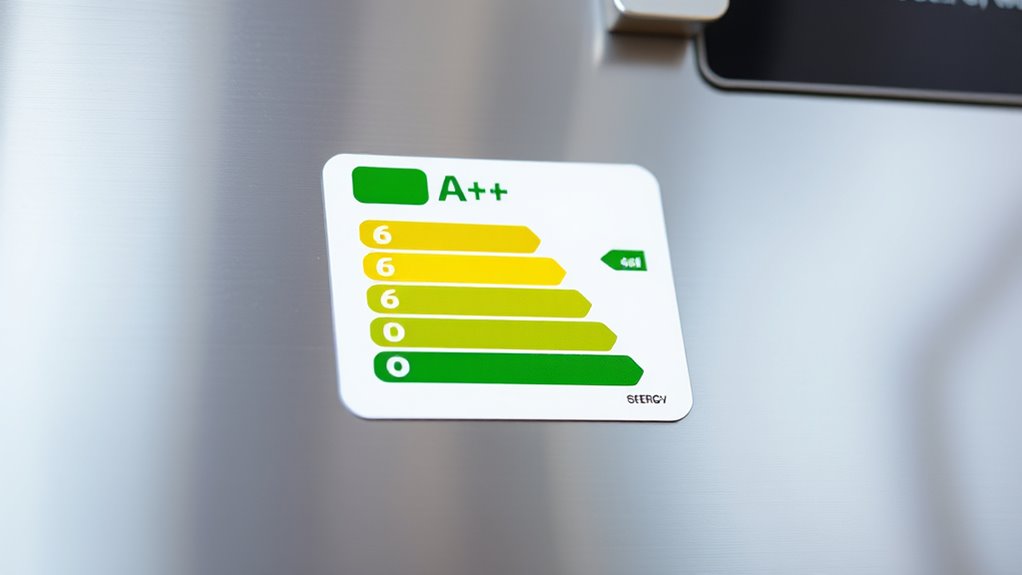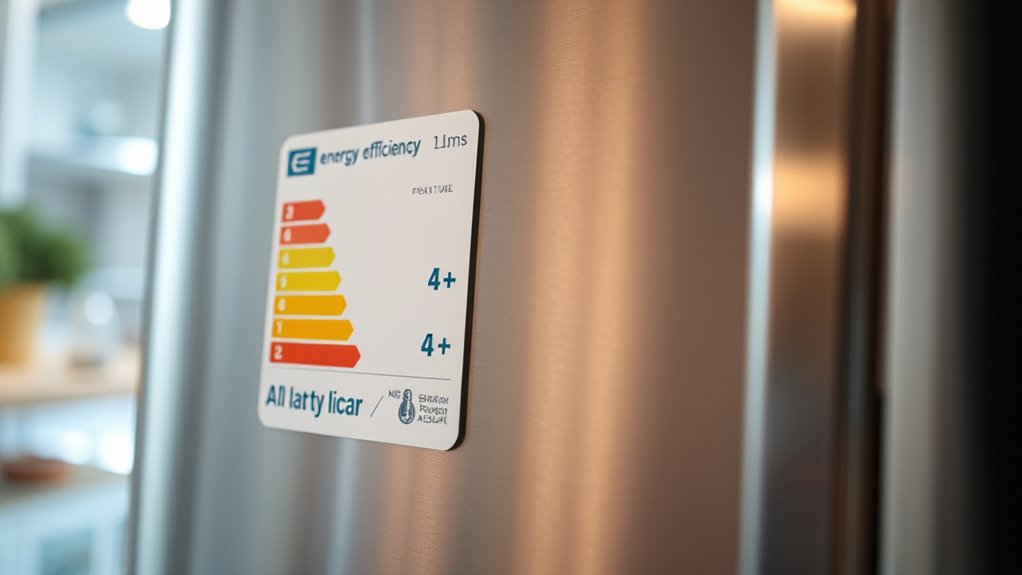A+++ ratings on energy labels suggest high efficiency, but they don’t always reflect real-world energy use or environmental impact. These ratings are based on standardized tests that might not match how you actually use appliances. Sometimes, appliances with top ratings can consume more energy than lower-rated ones. To truly understand how an appliance performs, consider specific energy consumption details. Keep exploring to uncover what these ratings really mean in everyday use.
Key Takeaways
- A+++ ratings indicate high energy efficiency but do not guarantee lower actual energy consumption for specific appliances.
- Ratings are based on standardized tests that may not reflect real-world usage or appliance size.
- High-rated appliances can sometimes use more energy than lower-rated models depending on features and capacity.
- The label simplifies comparison but should be supplemented with actual energy consumption data for accuracy.
- Environmental benefits depend on proper usage, lifespan, and testing conditions, not just the rating alone.

Have you ever questioned whether energy labels truly reflect a product’s efficiency? It’s a common thought, especially when you see those eye-catching A+++ ratings on appliances. At face value, they suggest you’re choosing the most efficient models available, but the truth is a bit more complex. These labels are designed to give you an at-a-glance idea of appliance efficiency, helping you compare products quickly. However, they don’t always tell the full story about how much energy an appliance actually consumes in your home or its overall environmental impact. Sometimes, a model with an A+++ rating might still use more energy than a less-rated one, depending on how you use it or its size and features. So, while energy labels aim to simplify decisions, they can sometimes be misleading if you don’t dig a little deeper.
Understanding what those ratings truly mean helps you make smarter choices that benefit both your wallet and the environment. For example, an appliance with a top-tier rating might seem like a no-brainer, but if it’s larger or has more features than you need, it could end up using more energy overall. Conversely, a slightly lower-rated model might be more suitable for your actual usage, saving you money and reducing your environmental impact. The key is to look beyond the label and consider specific energy consumption figures, which are often available in product specifications. By doing so, you gain a clearer picture of how an appliance will perform in your home and what kind of environmental footprint it will leave.
Another aspect to take into account is how appliance efficiency impacts the environment. High-rated appliances generally consume less energy, which means they produce fewer greenhouse gases if your electricity comes from fossil fuels. But the real environmental benefit depends on your usage habits and the lifespan of the appliance. An efficient model that’s used sparingly can be more eco-friendly than a less-efficient one that’s used constantly. Also, manufacturers’ claims and the rating system itself can sometimes be influenced by factors like testing conditions or newer technology that might not be fully represented in the label. This disconnect can make it tricky to judge the true environmental impact of an appliance based solely on its rating. Additionally, understanding the testing conditions and how they relate to real-world use can help you better assess an appliance’s true efficiency.
Frequently Asked Questions
How Do Energy Labels Impact the Actual Lifespan of Appliances?
When you consider how energy labels impact appliance durability, you see they influence your choice and usage. Although labels help identify efficiency, label accuracy varies, so they don’t guarantee longer lifespan. Proper maintenance and usage are key to extending appliance life. Relying solely on energy ratings might mislead you, but understanding their limitations helps you make smarter decisions, ensuring your appliances last longer and perform better over time.
Are Higher-Rated Appliances Always More Environmentally Friendly?
Did you know that higher-rated appliances can sometimes have larger manufacturing impacts? While they’re often more energy-efficient, their production may involve more resource use, which affects recycling benefits and environmental friendliness. So, higher ratings don’t always mean greener choices. You should consider the full lifecycle, including manufacturing impacts, to truly assess how environmentally friendly an appliance is. Sometimes, a less-rated appliance might have a smaller overall ecological footprint.
Can Energy Labels Change Over an Appliance’S Lifetime?
You might wonder if energy labels change over an appliance’s lifetime. Yes, energy label updates can reflect real changes, but label accuracy isn’t always perfect. As appliances age or are used more, their efficiency can decline, which might not immediately show on labels. Regularly check for updates or new labels to get the most accurate info. This helps you make informed choices and understand how your appliance’s efficiency evolves.
Do Energy Labels Account for Energy Consumption During Standby Mode?
Ever wonder if those energy labels count standby power? Well, surprise! They do include standby consumption, which is often the sneaky villain in your energy savings. So, when you see that shiny A+++ rating, know it reflects not just active use but also standby mode. That means your appliance’s energy efficiency isn’t just about working hard—it’s about not wasting power when it’s pretending to sleep.
How Can I Compare Energy Labels Across Different Appliance Categories?
You can compare energy labels across different appliance categories by understanding appliance standards and label variations. Look at the energy efficiency classes, noting that higher ratings like A+++ indicate better performance. Keep in mind that labels might differ between appliances, so always check the specific criteria for each category. This helps you make informed choices, ensuring you’re selecting energy-efficient appliances regardless of their category or label variations.
Conclusion
So, next time you see those A+++ labels, remember—they’re not just symbols but a hidden story about efficiency and impact. Don’t let the illusion of perfection fool you; it’s a reminder to look deeper and make smarter choices. After all, isn’t it time we stop chasing the highest rating and start valuing real energy savings? The labels may shine bright, but your awareness can make the real difference in a world craving change.









